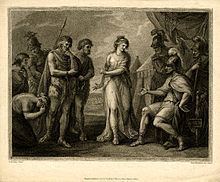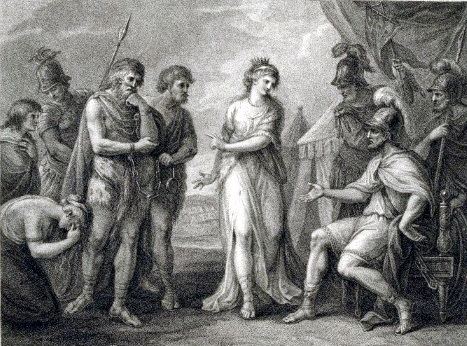Reign c. AD 43 – c. AD 69 Father unknown | Predecessor unknown Mother unknown | |
 | ||
Died Great Britain, United Kingdom Similar | ||
Cartimandua v boudicca
Cartimandua or Cartismandua (reigned c. AD 43 – c. 69) was a 1st-century queen of the Brigantes, a Celtic people living in what is now northern England. She came to power around the time of the Roman conquest of Britain, and formed a large tribal agglomeration that became loyal to Rome. Our only knowledge of her is through the Roman historian Tacitus, though she appears to have been widely influential in early Roman Britain.
Contents

Her name may be a compound of the Common Celtic roots *carti- "chase, expel, send" and *mandu- "pony".
Cartimandua
History

Although Cartimandua is first mentioned by Tacitus as in 51 CE, her rule over the Brigantes may have already been established when the Roman emperor Claudius began the organized conquest of Britain in 43: she may have been one of the eleven "kings" who Claudius's triumphal arch says surrendered without a fight. If not, she may have come to power after a revolt of a faction of the Brigantes was defeated by Publius Ostorius Scapula in 48. Of "illustrious birth" according to Tacitus, she probably inherited her power, as she appears to have ruled by right rather than through marriage. She and her husband, Venutius, are described by Tacitus as loyal to Rome and "defended by our [Roman] arms". In 51 the British resistance leader Caratacus sought sanctuary with Cartimandua after being defeated by Ostorius Scapula in Wales, but Cartimandua handed him over to the Romans in chains.

Having given Claudius the greatest exhibit of his triumph, Cartimandua was rewarded with great wealth. She later divorced Venutius, replacing him with his armour-bearer, Vellocatus. In 57, although Cartimandua had seized his brother and other relatives and held them hostage, Venutius made war against her and then against her Roman protectors. He built alliances outside the Brigantes, and during the governorship of Aulus Didius Gallus (52–57) he staged an invasion of the kingdom. The Romans had anticipated this and sent some cohorts to defend their client queen. The fighting was inconclusive until Caesius Nasica arrived with a legion, the IX Hispana, and defeated the rebels. Cartimandua retained the throne thanks to prompt military support from Roman forces.
She was not so fortunate in 69. Taking advantage of Roman instability during the year of four emperors, Venutius staged another revolt, again with help from other nations. Cartimandua appealed for troops from the Romans, who were only able to send auxiliaries. Cartimandua was evacuated, leaving Venutius in control of a kingdom at war with Rome. After this, Cartimandua disappears from the sources.
Her life story is fictionalised in Barbara Erskine's novel Daughters of Fire and she plays a minor but important role in George Shipway's The Imperial Governor as the lover and ally of General Suetonius Paulinus.
Representation by Tacitus
In his Annals and the Histories, Tacitus presents Cartimandua in a negative light. Although he refers to her loyalty to Rome, he invites the reader to judge her "treacherous" role in the capture of Caratacus, who had sought her protection; her "self-indulgence" her sexual impropriety in rejecting her husband in favour of a common soldier; and her "cunning strategems" in taking Venutius' relatives hostage. However, he also consistently names her as a queen (regina), the only one such known in early Roman Britain. Boudica, the only other female British leader of the period, is not described in these terms.
